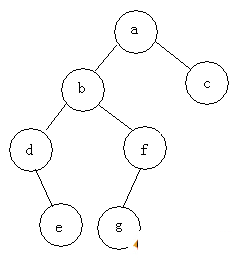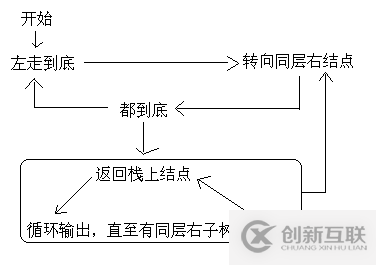C語言中二叉樹的常見操作是什么-創(chuàng)新互聯(lián)
這篇文章主要講解了“C語言中二叉樹的常見操作是什么”,文中的講解內(nèi)容簡(jiǎn)單清晰,易于學(xué)習(xí)與理解,下面請(qǐng)大家跟著小編的思路慢慢深入,一起來研究和學(xué)習(xí)“C語言中二叉樹的常見操作是什么”吧!
創(chuàng)新互聯(lián)公司是一家專業(yè)提供霍林郭勒企業(yè)網(wǎng)站建設(shè),專注與做網(wǎng)站、網(wǎng)站設(shè)計(jì)、html5、小程序制作等業(yè)務(wù)。10年已為霍林郭勒眾多企業(yè)、政府機(jī)構(gòu)等服務(wù)。創(chuàng)新互聯(lián)專業(yè)的建站公司優(yōu)惠進(jìn)行中。一、基本概念
每個(gè)結(jié)點(diǎn)最多有兩棵子樹,左子樹和右子樹,次序不可以顛倒。
性質(zhì):
1、非空二叉樹的第n層上至多有2^(n-1)個(gè)元素。
2、深度為h的二叉樹至多有2^h-1個(gè)結(jié)點(diǎn)。
滿二叉樹:所有終端都在同一層次,且非終端結(jié)點(diǎn)的度數(shù)為2。
在滿二叉樹中若其深度為h,則其所包含的結(jié)點(diǎn)數(shù)必為2^h-1。
完全二叉樹:除了較大的層次即成為一顆滿二叉樹且層次較大那層所有的結(jié)點(diǎn)均向左靠齊,即集中在左面的位置上,不能有空位置。
對(duì)于完全二叉樹,設(shè)一個(gè)結(jié)點(diǎn)為i則其父節(jié)點(diǎn)為i/2,2i為左子節(jié)點(diǎn),2i+1為右子節(jié)點(diǎn)。
二、存儲(chǔ)結(jié)構(gòu)
順序存儲(chǔ):
將數(shù)據(jù)結(jié)構(gòu)存在一塊固定的數(shù)組中。
#define LENGTH 100
typedef char datatype;
typedef struct node{
datatype data;
int lchild,rchild;
int parent;
}Node;
Node tree[LENGTH];
int length;
int root;雖然在遍歷速度上有一定的優(yōu)勢(shì),但因所占空間比較大,是非主流二叉樹。二叉樹通常以鏈?zhǔn)酱鎯?chǔ)。
鏈?zhǔn)酱鎯?chǔ):
typedef char datatype;
typedef struct BinNode{
datatype data;
struct BinNode* lchild;
struct BinNode* rchild;
}BinNode;
typedef BinNode* bintree; //bintree本身是個(gè)指向結(jié)點(diǎn)的指針三、二叉樹的遍歷
遍歷即將樹的所有結(jié)點(diǎn)訪問且僅訪問一次。按照根節(jié)點(diǎn)位置的不同分為前序遍歷,中序遍歷,后序遍歷。
前序遍歷:根節(jié)點(diǎn)->左子樹->右子樹
中序遍歷:左子樹->根節(jié)點(diǎn)->右子樹
后序遍歷:左子樹->右子樹->根節(jié)點(diǎn)
例如:求下面樹的三種遍歷

前序遍歷:abdefgc
中序遍歷:debgfac
后序遍歷:edgfbca
四、遍歷的實(shí)現(xiàn)
遞歸實(shí)現(xiàn)(以前序遍歷為例,其他的只是輸出的位置稍有不同)
void preorder(bintree t){
if(t){
printf("%c ",t->data);
preorder(t->lchild);
preorder(t->rchild);
}
}非遞歸的實(shí)現(xiàn)
因?yàn)楫?dāng)遍歷過根節(jié)點(diǎn)之后還要回來,所以必須將其存起來。考慮到后進(jìn)先出的特點(diǎn),選用棧存儲(chǔ)。數(shù)量確定,以順序棧存儲(chǔ)。
#define SIZE 100
typedef struct seqstack{
bintree data[SIZE];
int tag[SIZE]; //為后續(xù)遍歷準(zhǔn)備的
int top; //top為數(shù)組的下標(biāo)
}seqstack;
void push(seqstack *s,bintree t){
if(s->top == SIZE){
printf("the stack is full\n");
}else{
s->top++;
s->data[s->top]=t;
}
}
bintree pop(seqstack *s){
if(s->top == -1){
return NULL;
}else{
s->top--;
return s->data[s->top+1];
}
}1、前序遍歷
void preorder_dev(bintree t){
seqstack s;
s.top = -1; //因?yàn)閠op在這里表示了數(shù)組中的位置,所以空為-1
if(!t){
printf("the tree is empty\n");
}else{
while(t || s.stop != -1){
while(t){ //只要結(jié)點(diǎn)不為空就應(yīng)該入棧保存,與其左右結(jié)點(diǎn)無關(guān)
printf("%c ",t->data);
push(&s,t);
t= t->lchild;
}
t=pop(&s);
t=t->rchild;
}
}
}2、中序遍歷
void midorder(bintree t){
seqstack s;
s.top = -1;
if(!t){
printf("the tree is empty!\n");
}else{
while(t ||s.top != -1){
while(t){
push(&s,t);
t= t->lchild;
}
t=pop(&s);
printf("%c ",t->data);
t=t->rchild;
}
}
}3、后序遍歷
因?yàn)楹笮虮闅v最后還要要訪問根結(jié)點(diǎn)一次,所以要訪問根結(jié)點(diǎn)兩次。采取夾標(biāo)志位的方法解決這個(gè)問題。
這段代碼非常糾結(jié),對(duì)自己有信心的朋友可以嘗試獨(dú)立寫一下。反正我是寫了很長(zhǎng)時(shí)間。邏輯不難,我畫了一張邏輯圖:

代碼:
void postorder_dev(bintree t){
seqstack s;
s.top = -1;
if(!t){
printf("the tree is empty!\n");
}else{
while(t || s.top != -1){ //棧空了的同時(shí)t也為空。
while(t){
push(&s,t);
s.tag[s.top] = 0; //設(shè)置訪問標(biāo)記,0為第一次訪問,1為第二次訪問
t= t->lchild;
}
if(s.tag[s.top] == 0){ //第一次訪問時(shí),轉(zhuǎn)向同層右結(jié)點(diǎn)
t= s.data[s.top]; //左走到底時(shí)t是為空的,必須有這步!
s.tag[s.top]=1;
t=t->rchild;
}else {
while (s.tag[s.top] == 1){ //找到棧中下一個(gè)第一次訪問的結(jié)點(diǎn),退出循環(huán)時(shí)并沒有pop所以為其左子結(jié)點(diǎn)
t = pop(&s);
printf("%c ",t->data);
}
t = NULL; //必須將t置空。跳過向左走,直接向右走
}
}
}
}4、層次遍歷:即每一層從左向右輸出
元素需要儲(chǔ)存有先進(jìn)先出的特性,所以選用隊(duì)列存儲(chǔ)。
隊(duì)列的定義:
#define MAX 1000
typedef struct seqqueue{
bintree data[MAX];
int front;
int rear;
}seqqueue;
void enter(seqqueue *q,bintree t){
if(q->rear == MAX){
printf("the queue is full!\n");
}else{
q->data[q->rear] = t;
q->rear++;
}
}
bintree del(seqqueue *q){
if(q->front == q->rear){
return NULL;
}else{
q->front++;
return q->data[q->front-1];
}
}遍歷實(shí)現(xiàn)
void level_tree(bintree t){
seqqueue q;
bintree temp;
q.front = q.rear = 0;
if(!t){
printf("the tree is empty\n");
return ;
}
enter(&q,t);
while(q.front != q.rear){
t=del(&q);
printf("%c ",t->data);
if(t->lchild){
enter(&q,t->lchild);
}
if(t->rchild){
enter(&q,t->rchild);
}
}
}5、利用前序遍歷的結(jié)果生成二叉樹
//遞歸調(diào)用,不存點(diǎn),想的時(shí)候只關(guān)注于一個(gè)點(diǎn),因?yàn)檫€會(huì)回來的,不要跟蹤程序運(yùn)行,否則容易多加循環(huán)
void createtree(bintree *t){
datatype c;
if((c=getchar()) == '#')
*t = NULL;
else{
*t = (bintree)malloc(sizeof(BinNode));
(*t)->data = c;
createtree(&(*t)->lchild);
createtree(&(*t)->rchild);
}
}6、二叉樹的查找
bintree search_tree(bintree t,datatype x){
if(!t){
return NULL;
}
if(t->data == x){
return t;
}else{
if(!search_tree(t->lchild,x)){
return search_tree(t->rchild,x);
}
return t;
}
}7、統(tǒng)計(jì)結(jié)點(diǎn)個(gè)數(shù)
int count_tree(bintree t){
if(t){
return (count_tree(t->lchild)+count_tree(t->rchild)+1);
}
return 0;
}8、比較兩個(gè)樹是否相同
int is_equal(bintree t1,bintree t2){
if(!t1 && !t2){ //都為空就相等
return 1;
}
if(t1 && t2 && t1->data == t2->data){ //有一個(gè)為空或數(shù)據(jù)不同就不判斷了
if(is_equal(t1->lchild,t2->lchild))
if(is_equal(t1->rchild,t2->rchild)){
return 1;
}
}
return 0;
}9、求二叉樹的深度
int hight_tree(bintree t){
int h,left,right;
if(!t){
return 0;
}
left = hight_tree(t->lchild);
right = hight_tree(t->rchild);
h = (left>right?left:right)+1;
return h;
}感謝各位的閱讀,以上就是“C語言中二叉樹的常見操作是什么”的內(nèi)容了,經(jīng)過本文的學(xué)習(xí)后,相信大家對(duì)C語言中二叉樹的常見操作是什么這一問題有了更深刻的體會(huì),具體使用情況還需要大家實(shí)踐驗(yàn)證。這里是創(chuàng)新互聯(lián)網(wǎng)站建設(shè)公司,,小編將為大家推送更多相關(guān)知識(shí)點(diǎn)的文章,歡迎關(guān)注!
網(wǎng)站名稱:C語言中二叉樹的常見操作是什么-創(chuàng)新互聯(lián)
URL標(biāo)題:http://chinadenli.net/article12/ccgigc.html
成都網(wǎng)站建設(shè)公司_創(chuàng)新互聯(lián),為您提供營(yíng)銷型網(wǎng)站建設(shè)、網(wǎng)站營(yíng)銷、商城網(wǎng)站、域名注冊(cè)、云服務(wù)器、定制開發(fā)
聲明:本網(wǎng)站發(fā)布的內(nèi)容(圖片、視頻和文字)以用戶投稿、用戶轉(zhuǎn)載內(nèi)容為主,如果涉及侵權(quán)請(qǐng)盡快告知,我們將會(huì)在第一時(shí)間刪除。文章觀點(diǎn)不代表本網(wǎng)站立場(chǎng),如需處理請(qǐng)聯(lián)系客服。電話:028-86922220;郵箱:631063699@qq.com。內(nèi)容未經(jīng)允許不得轉(zhuǎn)載,或轉(zhuǎn)載時(shí)需注明來源: 創(chuàng)新互聯(lián)
猜你還喜歡下面的內(nèi)容
- 學(xué)習(xí)筆記day10C語言:高級(jí)命令與shell-創(chuàng)新互聯(lián)
- 怎么在Linux中實(shí)現(xiàn)雙網(wǎng)卡綁定腳本-創(chuàng)新互聯(lián)
- Python開發(fā)的主要應(yīng)用領(lǐng)域-創(chuàng)新互聯(lián)
- python中for循環(huán)的一般格式是什么-創(chuàng)新互聯(lián)
- 小網(wǎng)站選擇什么虛擬主機(jī)好-創(chuàng)新互聯(lián)
- MySQL數(shù)據(jù)庫是干什么的-創(chuàng)新互聯(lián)
- java與php哪個(gè)比較容易學(xué)-創(chuàng)新互聯(lián)

- 福州企業(yè)建站中容易被忽視的三大問題 2016-05-19
- 企業(yè)建站常見的9個(gè)域名錯(cuò)誤 2022-11-06
- 成都網(wǎng)站制作用這種方式企業(yè)建站可以節(jié)省大量成本 2016-09-02
- 企業(yè)建站的目的是什么?如何選擇好的企業(yè)網(wǎng)站系統(tǒng) 2021-02-26
- 企業(yè)建站的價(jià)值點(diǎn)(一) 2016-11-27
- 企業(yè)建站的規(guī)則及其相關(guān)要點(diǎn),想明白就一定要先了解! 2022-08-30
- 個(gè)人建站與企業(yè)建站間的區(qū)別在哪? 2021-04-24
- 中小型企業(yè)建站專家,網(wǎng)站是貴公司線上的門面 2016-11-16
- 中小企業(yè)建站如何做到讓人驚艷 2022-10-31
- 江門企業(yè)建站:企業(yè)想搭建一個(gè)網(wǎng)站都是要做哪些方面的工作? 2021-10-16
- 企業(yè)建站租用服務(wù)器應(yīng)該考慮的兩個(gè)因素 2022-10-05
- 企業(yè)建站流程有哪些方面? 2021-11-30